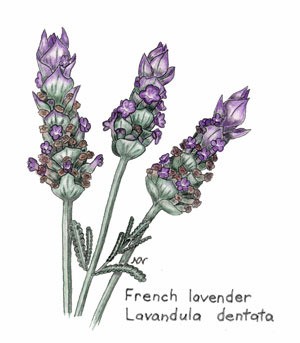
Aurea. Purpurea. Triangularis. Variegata. For some gardeners, the thought of trying to understand (let alone pronounce) complex botanical terms can seem intimidating. And while you certainly don't need to understand botany or Latin to grow a successful garden, a basic understanding of the language of horticulture can deepen your appreciation for the plants you grow and be downright handy when your shopping for plants. Here's a brief and very simple explanation of the how's and why's behind 5 common botanical terms.
Carlolus Linnaeus was an 18th century Swedish botanist on a mission. He set out to improve the way that plants (and animals) were named and classified. The result of his work was a classification system that the world now refers to as Binomial Nomenclature (Bi = two and Nom = name; "two names"). At first glance, this system may seem cumbersome and complex to the laymen, but it actually presents the entire world with an easier way to classify organisms using the same accepted name. This system provides plants (and animals) with a first name (genus) and a second name (species), just like people.
The Genus, or first name of a plant, refers to a group of plants that share certain structural characteristics. These names often come from mythology, literature, people, places or an object or characteristic the plant resembles. Just like your last name identifies you as being a member of a particular group (e.g. the "Brown" clan), so does the Genus name of a plant.
The species, or second name of a plant, is used to identify specific plants by their individual characteristics or appearance. The species name of a plant is usually related to where the plant comes from, it's physical appearance or the name of the person who discovered it. Think of a plant's species name like identifying a specific member of your family ("Ellen" of the Brown clan). Species is sometimes abbreviated sp. or spp.
In the same way the people are asked to fill out their names on formal documents (Brown, Ellen), when the genus and species names of plant are being written together, they are written in a particular way- Genus species. The first letter of the genus name is always capitalized, followed by the species name in lower case. Both names are italicized.
Are you confused yet? I hope not. Another term that comes up frequently by those "in the know" is Variety. This term is used to describe a subdivision of a species in which naturally occurring changes have occurred (changes without human intervention) that have created a plant which is distinctly different in appearance. For example, a genetic mutation may naturally occur when a species of plant grows on another continent. The result may be a taller plant of a different color. When these changes occur naturally through reproduction, they are said to be true varieties or forms, sometimes written with the abbreviation var. or form.
Cultivar is short for cultivated variety. It's a term used to identify a plant characteristic that originally occurred naturally, but can only be replicated by asexual reproduction and human intervention. In other words, someone discovered a species of plant with a particular, appealing characteristic not usually presented in that "normal" plant species. They then selected this particular plant and specifically cultivated this variety of the species to produce more plants which display that appealing characteristic. Hence, they cultivated this variety of the plant (cultivar) to produce more plants with this specific characteristic (e.g.
Hang in there, it's almost over. This is the last important term. A Hybrid plant is a variety that is created through human intervention by crossing one plant with another. This cross results in a distinctively new plant. For example, suppose a plant breeder has a plant that produces well but he doesn't like the color of the flower. He also has another plant with great color, but it produces poorly. He crosses one plant with another to get a good producing plants with good flower color.

About The Author: Ellen Brown is an environmental writer and photographer and the owner of Sustainable Media, an environmental media company that specializes in helping businesses and organizations promote eco-friendly products and services. Contact her on the web at http://www.sustainable-media.com
Add your voice! Click below to comment. ThriftyFun is powered by your wisdom!
A fantastic article. I teach Jr. Master Gardener classes to 3rd and 4th graders at local schools. I talk to them about using botanical names (they love the big words) and I have a little exercise for them that seems to get my point across. I tell the children that we are all at a huge international conference on flowers. I ask each one to pick a country (non-English speaking) that they are from and think of their favorite flower.
Add your voice! Click below to comment. ThriftyFun is powered by your wisdom!